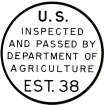In all the news about recalls in the food industry, have you ever wondered how USDA tracks a meat item back to the plant where it was produced? Do your consumer friends want to know where the meat you sell them was harvested and or cut and wrapped? The answer is quite simple although you’ll need to know about the USDA Establishment (EST) Number on food packaging and have access to the USDA web site pdf file that lists all of the harvest and processing plants.
All containers of meat, poultry, and egg products must be labeled with a



USDA mark of inspection and establishment (EST) number, which is assigned to the plant where the product was produced. The pictures above show a typical meat product “EST” number, a poultry product “EST” number and an egg products “EST” number, respectively.
The “EST” number may appear on the package within the USDA mark of inspection like the pictures shown, but it may also appear elsewhere on the exterior of the package container or package labeling (for example on the lid of a can) if shown in a prominent and legible manner. It must also be in a size that is large enough to insure easy visibility and recognition.
Once you find the “EST” number you can go to the USDA web site at http://www.fsis.usda.gov/regulations_&_Policies/Meat_Poultry_Egg_Inspection_Directory/index.asp where both an alphabetical and numerical directory pdf files are located. Since the “EST” number is usually the only information on the package, you’ll want to pull up the numerical directory. Using Adobe Acrobat’s Find in document command you can type in the “EST” number. (Note: I wouldn’t attempt to print out the entire directory as it is several reams of paper.) The direct link to the numerical pdf is: http://www.fsis.usda.gov/PDF/MPI_Directory_by_Est_No_Pgs_1_200.pdf. It is also handy to know the legend for EST numbers.
- G = Egg Product (Example: G1632 or 01632 G)
- I = Import (Example: I271 or 00271 I_
- M = Meat (Example: 19924 or 19924 M – notice that the first example has no letter)
- P = Poultry (Example: P9002 or 09002 P)
- Multiple numbers: Some establishments have more than one “EST” number because they may process more than one type of meat or product. (Example: 13375 M and 13375 P)
Once in the directory you’ll learn not only that several companies do business under several names but you’ll be able to tell what kind of operations they do. For example:
- Slaughter
- Processing
- Import
- ID warehouse.
So now you know how USDA can track that meat back to the plant where it was produced and you also know how to tell how “local” at least in terms of harvest and processing your meat is.
Author - County Director Mendocino & Lake/Livestock & Natural Resources Advisor - Emeritus